On November 28, 2016, a wildfire of unprecedented proportions raged across the Great Smoky Mountains National Park (GSMNP) and the surrounding community, engulfing 17,904 acres, including 55 miles of the Park’s premier trout streams. Today, spring has sprung, and the Park remains largely ecologically intact.
The fire began atop Chimney Tops, one of GSMNP’s most popular landmarks and trails, and was fueled by severe drought conditions and winds in excess of 87 mph. In the nearby tourism town of Gatlinburg, it claimed 14 lives and numerous structures.
Fire is relatively absent from the native, eastern perspective; very few large wildfires occur in the East when compared to the western United States. As such, the Chimney Tops 2 fire was advertised as a catastrophe that devastated GSMNP. However, though the loss of life and property cannot be downplayed, the reality of the fire’s ecological impact is not nearly so harrowing.
The 17,904-acre area consumed by the wildfire comprises just two percent of the 522,427-acre park’s total area. Of that area, because of high winds driving the flames, only about 1,000 acres burned intensely, resulting in dead trees and destroyed organic soil layers in just 0.2 percent of the Park’s expanse.
As I walked through the burned region of GSMNP in early March, hope sprouted from the ground as fresh wildflowers and grasses of a ripe green. I became convinced that the habitat affected by the fire might even prove beneficial to the ecological diversity of the Park.
Contained within the nearly 18,000 acres that burned are several of the Park’s most popular and productive trout streams. GSMNP is a stronghold for wild trout habitat in the Southeast, and a rich panoply of pure southern Appalachian brook trout populations. Because the fire sparked during intense drought, even the riparian areas that wouldn’t normally burn in the temperate rainforest were scorched.

Chris Turner is a Sevierville, TN local and avid angler who, along with Chad Fouts of Smoky Mountain Angler, established Project Smoky Mountain Rebirth, realizing that there needed to be a concerted effort to overcome the images of charred forests and turbid streams burned into the minds of non-locals—all 11.3 million of them that visit the Smokies annually.
“Those 18,000 acres include a lot of the waters we fish locally, and it was hard to go back, at first,” said Turner.
When Turner did return to some of this favorite mountain streams within the burned area, he was pleased to find them intact and thriving. “It was amazing to see the green, to see spring come out in full force. I’ve never seen wildflowers this bright and voracious,” said Turner. “The fish are wild and hungry. It’s a beautiful sight.”
The science agrees with many anglers’ conclusions. “We do not anticipate any fisheries related impacts in streams within the burn area,” said Matt Kulp, Supervisory Fishery Biologist for GSMNP. “Given that the fire occurred in late November, most, if not all, of the species effected would have already spawned. Eggs in the gravel should have been protected from any potential fire affects.”

Most of the concern for fishery health in the aftermath of a large wildfire is related to sedimentation as a result of erosion of burned organic matter and exposed soil, which can fill in spaces in streambeds where fish deposit eggs, and, in some cases, damage fish gills and suffocate eggs and aquatic larvae living on the bottom.
Kulp and his team of fisheries biologists have been monitoring sediment movement, as well as water chemistry, in the streams effected by the fire and have not noticed any significant variation in pre- and post-fire data.
On that early March afternoon that I walked through the burned area noticing sprouting grasses and wildflowers, I did it with a fly rod—a short, slow three-weight, a tool designed to pay respects to the beautiful southern Appalachian brook trout in its tight and tangled home. In a half hour’s time, I plucked seven spritely salmonids from a small trickle with a dry fly. And I did it amid a very wild landscape, one that has been ebbing and flowing in the East for millennia.

Others are having the same reaction, along with a sense of renewed ownership and appreciation for what we, as American citizens, all own. “It was eerie but encouraging to see a burned tree trunk and the green grass that shows we can come back from this,” said Turner. “With enough casts and enough fish, all that falls away, and you see it for what it’s always been. You get to see a side of nature, of the stream, and of your backyard for what it is—a natural wonder that can’t be taken for granted. Our park is coming back, and the fish never slowed down.”




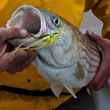






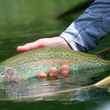
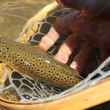



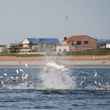
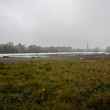



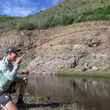








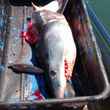

Comments
Tom Adkinson replied on Permalink
This is solid reporting and commentary. I attended the explanatory program that Matt did and fished with him afterwards (that's my lanky form in his lead photo, and I don't think I've ever liked a photo of me more), and it was indeed reassuring to hear from fisheries biologists that the streams in the fire zone were unaffected.
Great Smoky Mountains National Park is one of the most extraordinary places on earth, and people appreciate it for many reasons. It warrants our support on many levels -- visitation, appreciation of National Park Service employees, membership in support groups such as Friends of the Smokies and advocacy with Congress to provide proper funds. The reality is that underfunding is a far more serious threat to the park's health and survival as we know it than last November's fire ever could have been.
Pages